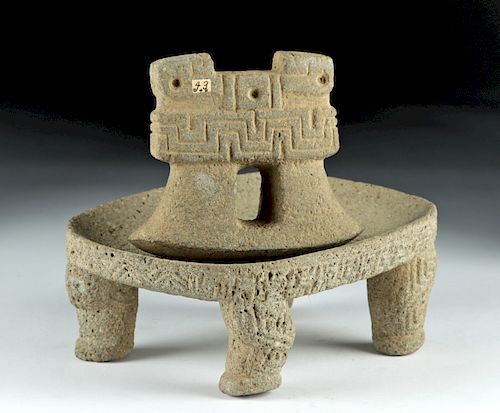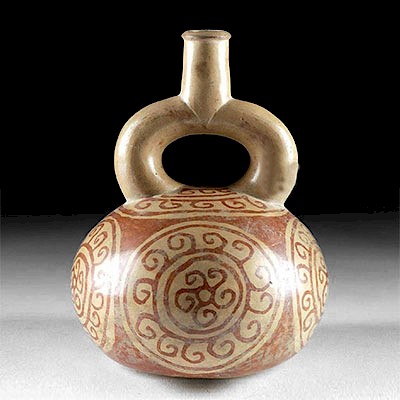Ceremonial Costa Rican Stone Metate & Stirrup Pestle
Lot 82b
About Seller
Artemis Fine Arts
686 S Taylor Ave, Ste 106
Louisville, CO 80027
United States
Selling antiquities, ancient and ethnographic art online since 1993, Artemis Gallery specializes in Classical Antiquities (Egyptian, Greek, Roman, Near Eastern), Asian, Pre-Columbian, African / Tribal / Oceanographic art. Our extensive inventory includes pottery, stone, metal, wood, glass and textil...Read more
Estimate:
$1,700 - $2,550
Absentee vs Live bid
Two ways to bid:
- Leave a max absentee bid and the platform will bid on your behalf up to your maximum bid during the live auction.
- Bid live during the auction and your bids will be submitted real-time to the auctioneer.
Bid Increments
| Price | Bid Increment |
|---|---|
| $0 | $25 |
| $300 | $50 |
| $1,000 | $100 |
| $2,000 | $250 |
| $5,000 | $500 |
| $10,000 | $1,000 |
| $20,000 | $2,500 |
| $50,000 | $5,000 |
| $100,000 | $10,000 |
| $200,000 | $20,000 |
About Auction
By Artemis Fine Arts
Jan 24, 2019
Set Reminder
2019-01-24 10:00:00
2019-01-24 10:00:00
America/New_York
Bidsquare
Bidsquare : Pre-Columbian / Ethnographic Art
https://www.bidsquare.com/auctions/artemis-gallery/pre-columbian-ethnographic-art-3814
Featuring ancient and ethnographic art from around the world, including Pre-Columbian, Native American, African / Tribal, Ethnographic, Spanish Colonial, Fossils, Fine Art, much more. Artemis Fine Arts info@artemisgallery.com
Featuring ancient and ethnographic art from around the world, including Pre-Columbian, Native American, African / Tribal, Ethnographic, Spanish Colonial, Fossils, Fine Art, much more. Artemis Fine Arts info@artemisgallery.com
- Lot Description
Pre-Columbian, Costa Rica, Pacific Slope, Guanacaste-Nicoya region, ca. 800 to 1200 CE. An extensively detailed metate and stirrup-shaped pestle - the concave, rectangular table on four zoomorphic legs, expertly carved from one piece of volcanic stone with refined dimensions and intricately incised details. Note the wonderful stylized zigzag and cross motifs adorning the exterior wall of the table and the angular geometric motifs on the limbs. The pestle is also outstanding. Far more interesting than the more pedestrian club-like form, this metate presents an almost architectural, temple-like design with intricately incised, abstract meanders and geometric motifs. A very special pair, most likely created for ceremonial use given their extensive decorative programs. Size: metate measures 8.375" W x 3.25" H (21.3 cm x 8.3 cm); pestle measures 5.25" W x 4.25" H (13.3 cm x 10.8 cm)
Metates were initially created to grind foods such as corn, certainly a utilitarian purpose, as well as hallucinogenic substances, medicines, etc. for ceremonial rituals; however, they evolved into meaningful ritual objects in and of themselves, replete with strong iconography and intriguing sculptural forms have transformed these objects into much more than pragmatic tools. Examples of a larger scale but with a similar degree of decorative carving and iconographic symbolism were sometimes used to seat a departed lord on his journey to the afterlife. Jaguar imagery symbolized power and might throughout the Pre-Columbian world; hence, warriors, rulers, hunters, and shamans alike associated themselves with this king of beasts, the largest and most powerful feline in the New World.
Provenance: ex-private Sneed collection, Florida, USA
All items legal to buy/sell under U.S. Statute covering cultural patrimony Code 2600, CHAPTER 14, and are guaranteed to be as described or your money back.
A Certificate of Authenticity will accompany all winning bids.
We ship worldwide and handle all shipping in-house for your convenience.
#137009Expected surface wear with minor nicks to edges of table, feet, edges and working surfaces of pestle, and high-pointed areas, but otherwise excellent. Earthen and mineral deposits grace the surface.Condition
- Shipping Info
-
All shipping is handled in-house for your convenience. Your invoice from Artemis Gallery will include shipping calculation instructions. If in doubt, please inquire BEFORE bidding for estimated shipping costs for individual items.
-
- Buyer's Premium



 EUR
EUR CAD
CAD AUD
AUD GBP
GBP MXN
MXN HKD
HKD CNY
CNY MYR
MYR SEK
SEK SGD
SGD CHF
CHF THB
THB















